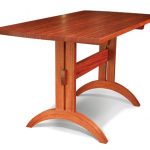We may receive a commission when you use our affiliate links. However, this does not impact our recommendations.
I spent last Thursday and Friday with two other judges staring at photographs and deciding if this was better than that. We were in a conference room at VeneerTech, deciding the winners in this year’s Craftsman’s Challenge contest. The winners will be announced in July at the AWFS fair in Las Vegas. One thing that struck all of us was how many entrants had to be eliminated not due to the quality of the work, but to the quality of their photographs and written descriptions. We tried our best to judge the furniture by its own merits, but all we had to go on were submitted photos and a couple of paragraphs. If you’re thinking about entering a contest such as this, or a juried show, or posting your work on the Internet, here are some things to consider.
Have someone else look over your photos before you submit them. A second pair of eyes can spot things that you might miss, such as a distracting background or a lack of detail. Find someone who isn’t afraid of hurting your feelings and ask if he or she understands what the piece is about. This is your one shot to make an impression – so make the most of it. Here are a few of the ways contestants shot themselves in the foot:
Out-of-focus or low-resolution photos. As we worked our way through the categories, we looked at all the entrants and eliminated the weakest ones. If we couldn’t tell what something was, or couldn’t see details, it wouldn’t be fair to judge by guessing. A quick shot from the camera in your cell phone won’t make the cut.
Bad lighting and distracting backgrounds. We weren’t expecting professional-quality photos, but we needed an accurate view of what we were looking at. Find a way to shoot in natural light, or with some means of lighting other than the camera’s flash. The burst of light from flash photos prevents details from being seen, and that wrinkled bed sheet is a distraction. Get a tripod so you can take a long exposure if needed.
If you can submit multiple photos, include a nice overall view and details. In this contest, entrants could submit several photos, and the pieces that won (or were in the running) showed the completed pieces from a couple of different angles and included close-ups of relevant details. As we moved closer to determining a winner, this became more of a factor. There were several pieces that we really liked, but we couldn’t tell enough about them to make a call.
Don’t let your own detail shots defeat you. If you do submit detailed close-ups, be careful; we had to eliminate a couple of entries that included nice clear photos of gappy joints.
If you’re asked for a written description, include one but don’t go on and on and on. Point out unique features and important details, but do so briefly.
One of the great things about digital photography is that you can see the photos as soon as you take them, rather than waiting for film to be processed. Compare the pictures you take to what you see online or in magazines, and don’t be afraid to experiment and take several shots to get a good one. One of our authors, Rob Millard, has a good article on his web site about taking photos of woodworking.
Here are some supplies and tools we find essential in our everyday work around the shop. We may receive a commission from sales referred by our links; however, we have carefully selected these products for their usefulness and quality.









